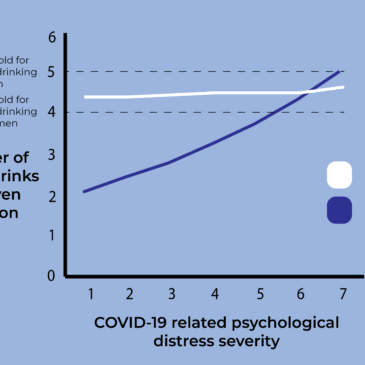The phrases “unprecedented times” and “new normal” are used all too frequently these days as the COVID-19 pandemic continues to threaten our country and those around the world. These “unprecedented times” bring new stressors, such as the fear of getting a friend or family member sick or the worry of losing one’s job. How do people handle this sudden additional stress? The self-medication hypothesis posits that people sometimes use substances or activities, such as video gaming, as a form of “medication” for psychiatric symptoms they are experiencing. This week, the DRAM reviews a study by Lindsey Rodriguez and colleagues that assessed whether perceived threat and psychological distress due to COVID-19 are associated with increased “self-medication” via alcohol.
What was the research question?
How are perceived threat and psychological distress due to the COVID-19 pandemic associated with changes in drinking behavior, and is this relationship different for men and women?
What did the researchers do?
Rodriguez and colleagues conducted an online survey of 754 individuals in the United States between April 17 and April 23, 2020, about one month after authorities enacted “stay-at-home” orders across the U.S. Participants had to be at least 18 years old, have consumed alcohol within the past 12 months, worked at least 20 hours per week and lived with a romantic partner who they have been with for at least six months. The survey asked about demographics, COVID-19 stressors (i.e., perceived threat and psychological distress due to COVID-19) and past month alcohol use. The researchers conducted a regression analysis to assess whether the COVID-19 stressors predicted past-month drinking behaviors. They included some covariates in these analyses such as the presence of children in the home and whether or not there was a ‘stay-at-home’ order in their location. They also tested whether gender moderated this relationship.
What did they find?
Psychological distress, but not perceived threat, due to COVID-19 was significantly associated with the number of maximum drinks consumed, the number of drinks consumed on a typical occasion, and the number of drinking days within the past month. In addition, both psychological distress and perceived threat due to COVID-19 were associated with more heavy drinking episodes during the past month. Having a child at home was also associated with having more drinks on a typical occasion and a greater number of heavy drinking episodes. Gender moderated the relationship between psychological distress due to COVID-19 and both the peak number of drinks and the typical number of drinks per occasion. Specifically, psychological distress was associated with a greater number of peak drinks and the typical number of drinks per drinking occasion for women but not men (see figure). For every one unit of increased psychological distress, the women reported 13% more drinks consumed during their heaviest drinking occasion and 16% more drinks on a typical drinking occasion during the past month.

Figure. Number of typical drinks per given occasion as a function of reported COVID-19 related psychological distress for men and women. Dotted lines indicate binge drinking cut-offs for men and women. Figure adapted from Rodriguez et al. (2020). Click on image to enlarge.
Why do these findings matter?
The findings provide preliminary support that some individuals, particularly women, are using alcohol to self-medicate the stress of the COVID-19 pandemic. Since the pandemic is affecting everyone across the globe and no “end-date” is certain, it is critical that research and public health officials continue to address these issues. Interventions that teach people healthier ways to cope with distress and fear of the pandemic would be helpful to prevent people from turning to substances, especially as cases have already started to rise again heading into the winter months. An example of this comes from the New York Times, with their recent article sharing 10 ways to calm down when you feel anxiety levels rising, such as moving for 3 minutes, connecting with nature, trying aromatherapy or accepting the present moment.
Every study has limitations. What are the limitations of this study?
This study sampled participants just one month after “stay-at-home” orders began. It is possible that people have established different routines, including changes in drinking behaviors, to align with the “new normal.” In addition, only gathering data on people in the United States who are living with a romantic partner provides a narrow view into the drinking that is going on in the country and around the world. Finally, it would be helpful to ask individuals what their motivations are for drinking in order to understand more about the causes of the increased drinking during COVID-19.
For more information:
For more details about addiction, visit our Addiction Resources page.
What do you think? Please use the comment link below to provide feedback on this article.
— Alessandra Grossman




